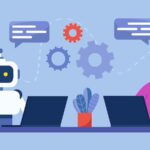How can we shape a sustainable and healthy future? The technology company IBM predicts for the next five years how companies will change and how they will make the earth a better planet again. We take a closer look at the IBM forecast.
The media keep drawing our attention to climate change and all kinds of problems on earth. We should not let ourselves be overwhelmed by this.
But apart from all the news, we should ask ourselves every day what we can do to make our personal, small world as sustainable, healthy and worth living in as much as possible. In this way, we are gradually initiating global change.
Nature offers us everything we need for a healthy life. An IBM forecast for the next five years now also falls into this notch.
IBM makes five predictions for a more sustainable, healthier future
IBM predicts that by 2025, companies will be able to make great strides towards a better world – among other things to feed the growing population and provide more environmentally friendly means of transport.
IBM makes five forecasts in total, which we will look at in more detail below.
1. IBM Forecast: Converting CO2 to mitigate climate change
In the next five years, according to IBM, we will be able to filter carbon dioxide from the air and convert it into something useful for the environment. The goal is to significantly reduce harmful CO2 in the atmosphere, recycle it as efficiently as possible and slow down climate change.
Until now, it has often only been possible to filter CO2 from other gases by chemical absorption and the use of membranes. While these processes are efficient, they are still too energy-intensive and costly for widespread use around the world.
Therefore, we need new materials and processes. An accelerated discovery cycle will help us to discover which materials and methods are available to us today.
2. IBM Forecast: Feeding the growing population
The second IBM prognosis is that we will again imitate nature more to convert the nitrogen in the atmosphere into nitrate-rich fertilizers. This should feed the growing world population while reducing the environmental impact of fertilizers.
Most of the earth is unpopulated. So theoretically, we have plenty of land available to grow sustainable fruits, vegetables and the like. However, this requires healthy soils and uncontaminated food.
After all, as long as humans work the soil, they are also dependent on nitrogen-based substances. This is how yields can be increased – whether through manure, compost or chemical fertilizers in industrial agriculture.
So nitrogen is a key component.
But there is a catch: plants can only use nitrogen in a “fixed” form. Certain bacteria at the roots of plants fix nitrogen naturally – this is how nature produces its own fertilizers to feed the plants we ultimately feed on.
3. IBM forecast: Environmentally friendly batteries
By 2025, we should discover new materials for safer and more environmentally friendly batteries. These should then support renewable energies and more sustainable transport.
Many renewable energy sources are intermittent and need to be stored. The use of artificial intelligence and quantum computing should therefore help to build more efficient and more powerful batteries.
Specifically, these are to be lithium-ion batteries with little or no cobalt. In addition, the batteries are to contain only non-flammable liquids.
4. IBM Forecast: Sustainable materials, sustainable products, sustainable earth
In the next five years, IBM predicts that we will drive forward materials manufacturing and enable semiconductor manufacturers to improve the sustainability of their desired products.
Scientists are expected to take a new approach to material design. This should enable the technical industry to produce sustainable materials for the production of semiconductors and electronic devices faster.
More than three decades ago, IBM was the first company to develop and use modern photoresists – i.e. colored coatings – for this purpose. IBM has been using this technology ever since.
Now that semiconductor chips are more widespread than ever before, the company wants to take a pioneering role again. IBM wants to ensure that the materials used to manufacture them are more efficient, effective and safe.
5. IBM forecast: A healthy future
Last but not least, by 2025, IBM wants to contribute to advancing and facilitating the development of treatments. Doctors and employees will then be supported in combating new types of viruses on a larger scale than is currently possible.
A combination of artificial intelligence, analyses and data will then help. Rapid analysis should make it possible to more reliably propose new candidates for drug testing and accelerate clinical trials.
In the future, these tools could be widely used in all industries, according to IBM. Ideally, we should then be able to respond globally and, above all, quickly to life-threatening viruses.
It would be desirable for medicine to focus on the human immune system at the same time.










